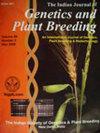Recent trends in crop breeding, the varietal induction in seed chain and its impact on food grain production in India
IF 0.8
4区 生物学
Q3 PLANT SCIENCES
引用次数: 1
Abstract
Food grains in India achieved an all-time high production (310.74 mt) during 2020-21. Varietal and seed replacement rates played an important role in achieving this milestone. A total of 1646 varieties of food crops comprising 1273 of cereals and 373 of pulses were released from 2011 to 2022. Of these 977 varieties consisting of cereals (667) and pulses (310) have been inducted into the seed chain during 2020-21. New breeding technonologies such as bio-fortification of food crops and marker-assisted breeding were applied to improve crop varieties with respect to specific desirable traits. A total of 65 bio-fortified varieties comprising rice (8), wheat (28), maize (14), pearl millet (9), finger millet (3), little millet (1) and lentil (2) have been released with improved levels of proteins, essential amino acids (lysine, tryptophan), vitamins (pro-vitamin A) and micro/macro-nutrients (zinc, iron, calcium). Marker-assisted breeding adopting foreground and background selections with targeted gene(s) utilizing molecular markers such as RFLPs, SSRs, CAPs, STS and INDEL resulted in to the development and release of 66 cultivars comprising rice (43), wheat (5), maize (10), pearl millet (2) and chickpea (6) with one/and or combination of traits such as tolerance to biotic/abiotic stresses, herbicide tolerance, nutrient use efficiency, earliness, nutritional and other quality traits. These non-genetically modified crop varieties are expected to play vital role in achieving food and nutrition security in India. The paper also provides insight in to the maintenance breeding of food crops. The analysis of seed requirement and availability during 2010-11 to 2020-21 revealed that seed requirements for cereals and pulses have increased consistently by 31.6% and 62.3%, from 186.8 to 245.8 lakh q and 22.3 to 36.2 lakh q, respectively. The production of rice, wheat, maize, pearl millet and pulses during 2020-21 increased over that of 2010-11 by 27.4%, 26.0%, 45.2%, 4.4% and 41.3%, respectively. The productivity of sorghum was higher by 18.9% over that of 2010-11 but production decreased by 31.7% on account of a reduction in acreage by 42.5% during the corresponding period. The net per capita availability of food grains increased, by 17.2% from 159.5 kg to 187.0 kg during this period. The cereals and pulses production needs to be up-scaled by 5.3% and 24.4% to meet the demand by 2030 from 285.28 mt and 25.46 mt, respectively, in 2020-21, with almost the similar acreage, degrading and depleting natural resources, thus, requiring a greater focus on enhancing yield/ha. Crop-specific breeding programmes should be accelerated with the adoption of new technologies like GM, gene editing, marker-assisted selection and speed breeding to address the challenges of climate change and degrading natural sources.印度作物育种的最新趋势、种子链中的品种诱导及其对粮食生产的影响
2020-21年,印度粮食产量创历史新高(310.74公吨)。品种和种子更替率在实现这一里程碑方面发挥了重要作用。2011年至2022年,共发布了1646个粮食作物品种,包括1273个谷物和373个豆类。在这977个由谷物(667个)和豆类(310个)组成的品种中,2020-21年已被引入种子链。应用新的育种技术,如粮食作物的生物强化和标记辅助育种,在特定的理想性状方面改进作物品种。共释放了65个生物强化品种,包括水稻(8)、小麦(28)、玉米(14)、珍珠小米(9)、手指小米(3)、小小米(1)和扁豆(2),蛋白质、必需氨基酸(赖氨酸、色氨酸)、维生素(维生素A原)和微量/大量营养素(锌、铁、钙)水平有所提高。利用RFLP、SSR、CAPs、STS和INDEL等分子标记,利用靶向基因的前景和背景选择进行标记辅助育种,培育和释放了66个品种,包括水稻(43)、小麦(5)、玉米(10)、珍珠小米(2)和鹰嘴豆(6),除草剂耐受性、养分利用效率、早熟性、营养等品质性状。预计这些非转基因作物品种将在实现印度粮食和营养安全方面发挥至关重要的作用。本文还对粮食作物的维持育种提供了见解。2010-11年至2020-21年期间对种子需求和可用性的分析显示,谷物和豆类的种子需求持续增长31.6%和62.3%,分别从186.8万q和223.3万q增加到245.8万q。2020-21年,水稻、小麦、玉米、珍珠小米和豆类的产量分别比2010-11年增长27.4%、26.0%、45.2%、4.4%和41.3%。高粱产量比2010-11年提高了18.9%,但由于同期种植面积减少了42.5%,产量下降了31.7%。在此期间,人均粮食净供应量增加了17.2%,从159.5公斤增加到187.0公斤。到2030年,谷物和豆类的产量需要分别从2020-21年的285.28公吨和25.46公吨增加5.3%和24.4%,以满足需求,面积几乎相同,会退化和消耗自然资源,因此需要更加注重提高每公顷产量。应通过采用转基因、基因编辑、标记辅助选择和快速育种等新技术,加快针对作物的育种计划,以应对气候变化和自然资源退化的挑战。
本文章由计算机程序翻译,如有差异,请以英文原文为准。
求助全文
约1分钟内获得全文
求助全文
来源期刊

Indian Journal of Genetics and Plant Breeding
PLANT SCIENCES-
CiteScore
1.80
自引率
10.00%
发文量
0
审稿时长
6-12 weeks
期刊介绍:
Advance the cause of genetics and plant breeding and to encourage and promote study and research in these disciplines in the service of agriculture; to disseminate the knowledge of genetics and plant breeding; provide facilities for association and conference among students of genetics and plant breeding and for encouragement of close relationship between them and those in the related sciences; advocate policies in the interest of the nation in the field of genetics and plant breeding, and facilitate international cooperation in the field of genetics and plant breeding.
 求助内容:
求助内容: 应助结果提醒方式:
应助结果提醒方式:


